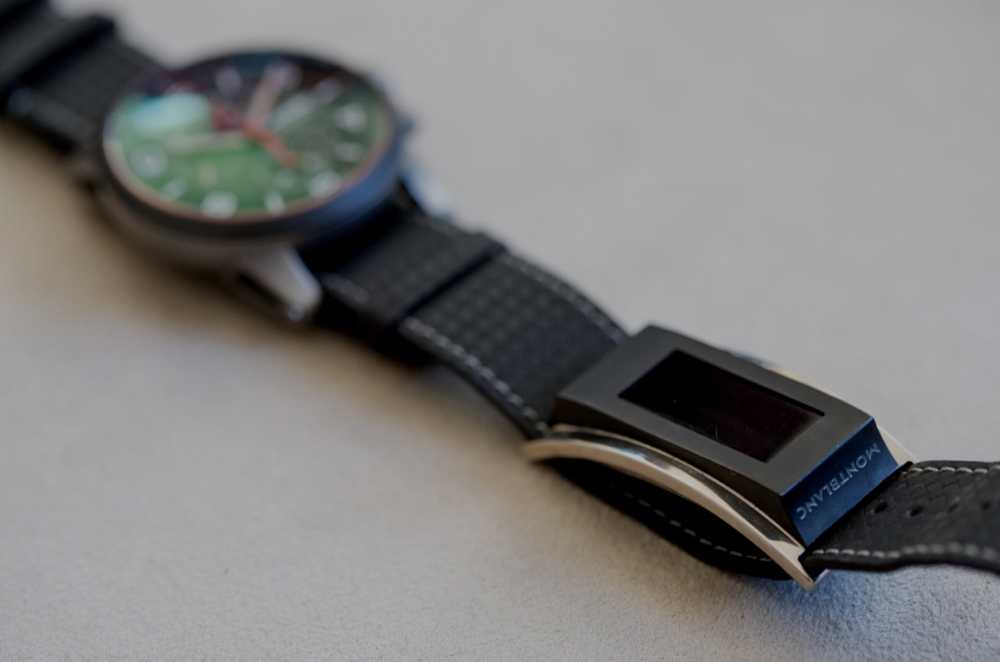
Montblanc Smartstrap Has Apple Watch In Its Sights
“This Swiss Company Just Totally Burned the Apple Watch.”
That’s the title of Benjamin Snyder’s silly piece over at TIME, where he discusses Montblanc’s “Apple Watch challenger,” a so-called smartstrap:
Alexander Schmiedt, Montblanc’s managing director for watches, told Bloomberg in an interview that electronics makers, like Apple, don’t focus on making items that last. “Our products should have very long life cycles,” he said. “That is not to say the Apple Watch is not a great product. I predict it will do very well, but I don’t think that customers are going to be ecstatic to throw away watches in one to two years when the technology is obsolete.”
The Montblanc device costs $349 for a basic version and up to $17,000 for a high-end version, which are price points similar to the Apple Watch. “The pricing is reasonable,” said analyst Patrik Schwendimann of Zuercher Kantonalbank to Bloomberg. “If it turns out to be just a fad, at least the consumer still has a nice, normal watch they can continue to wear.”
I can’t tell if Snyder thinks Montblanc burned Apple by introducing (or, since this has been announced for a while now, reintroducing) a limited-use electronic add-on, or if he’s simply saying that the Swiss maker zinged Apple with accusations of obsolescence and non-“timelessness,” or if he simply doesn’t have a clue because his prices are all wrong: The Montblanc smartstrap is only $390, and though newer versions made of more premium materials are said to be coming soon (if sales warrant, which I seriously doubt), they’ve not been announced or priced yet.
But none of that really matters anyways, because Snyder — and Montblanc — are plain wrong all over. Firstly, most mechanical watches are far from timeless. Go have your Rolex or JLC repaired and see just how expensive maintaining that adjective actually is. In my book, your product can’t be timeless without also being durable, unless it’s a veritable design icon that’s proved its mettle over many decades. Secondly, mobile technology doesn’t expire as quickly as it used to, and the first-generation Apple Watch won’t be past its prime for three to five years. And even then, customers won’t “throw away” anything, as it’s pretty much standard practice to gift or resell used mobile tech whenever one moves on to an upgrade. Thirdly, and perhaps most importantly, is the very nature of the claim coming out of Montblanc when coupled with their ironic product response to it. Their straps — straps! — cost more at $390 than Apple’s 38mm Sport (and $10 less than the 42mm version), yet they claim that, if this smartwatch business is all just a fad, their “consumer still has a nice, normal watch they can continue to wear.” Never mind that that nice, normal watch costs thousands of dollars on top of the brand’s Apple Watch-priced smartstrap, putting any wasted cash exactly in line with a discarded Apple Watch.
That means that for the same price as one of Montblanc’s ugly, bulky, inelegant mashups (I mean, look at it), you can buy an Apple Watch and… a Montblanc! Then, if the trend ends and you feel like a washed-up poser, you can get rid of the Apple Watch and, just like Montblanc’s customers, sport that nice Swiss timepiece, having lost nary a comparative cent. It’s a total wash. Dollar for dollar, Montblanc is competing directly with Apple Watch by selling a smartstrap. That’s stupid.
It’s even stupider when you consider that Montblanc’s solution (to a problem that doesn’t even exist in its industry) is to go toe-to-toe with a much more robust electronic platform than they themselves offer. Here’s what their “e-Strap” (yes, really) actually does, per Bloomberg:
The e-Strap consists of a stainless steel display attached via a leather strap and designed to be on the backside of the wrist when the watch is on the front. A two-line touchscreen displays e-mails when they arrive. When connected to a smartphone, Montblanc’s device can select songs and jump through playlists. It has an activity tracker that allows users to set targets for calories burned and steps taken. The e-Strap can also trigger the phone’s camera, facilitating easier “selfie” shots and group photos.
The watchband is compatible with phones from Samsung, Apple and others. The e-Strap also has a function to help the wearer find the watch or smartphone as long as they’re in a 30-meter (98-foot) range. It needs a recharge every five days.
While it does make a Swiss watch smart, the e-Strap isn’t flawless, according to Mario Ortelli, an analyst at Sanford C. Bernstein in London.
“There are also disadvantages: fewer functionalities, smaller screen, less integration with other devices,” he said.
Fewer functionalities? Try thousands of fewer functionalities (and more each day). I’d compare this — visually and functionally — to stitching a Pebble to the underside of a watch strap, but it costs way more and does way less. Smartwatches aren’t a fad; they’re here to stay. But smartstraps (or featurestraps, as they ought to be called) most assuredly are, and all that brands like Montblanc and IWC and Gucci are doing is cheapening their own pedigree and luxury allure (well, maybe not Gucci) by showing such fear and floundering in the face of imagined competition.
My advice to the luxury Swiss watch industry is the same as it ever was: When it comes to Apple Watch, just ignore it.